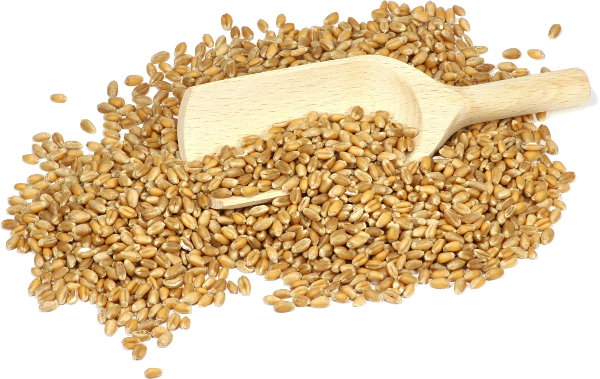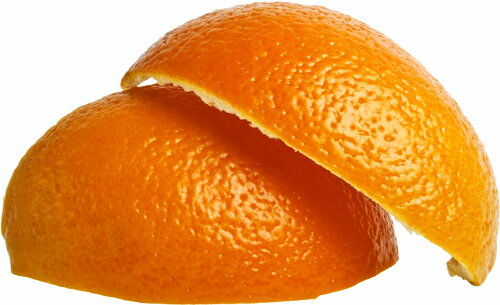The term "dietary fibre" is generally defined as the set of plant compounds that cannot be digested by the human digestive tract secretions.
The composition of the cell walls of plants varies depending on the species considered. In general, most of the plant cell walls contain 35% insoluble fibre, 45% of soluble fibres, 17% of miscellaneous fibres, 3% protein and 2% of ash. Dietary fibres are the sum of these constituents.
Insoluble Fibres
The best example of insoluble fibre is wheat bran, rich in cellulose and relatively insoluble in water, with binding capacity.
This capacity explains its effect to increase volume and mass of the faeces, thus promoting regular bowel activity. The cellulose cannot be digested by humans, but is partially digested by the intestinal microflora.
This process of natural fermentation, which occurs in the colon, causes degradation of almost 50% of the cellulose and is an important source of short-chain fatty acids that nourish the intestinal cells.

Wheat bran is rich in insoluble fibre
|
Categories of fibres |
Chemical structure |
Sources |
Physiological effect |
|
Cellulose |
1-4-beta-D-glucose polymer without branching |
The main component of plant walls; wheat bran |
Weight gain and fecal volume |
|
Gum |
Branched chain polymers containing uronic acid |
Karaya; Arabic gum |
Like above; it binds bile acids; reduces cholesterol |
|
Mucilage |
Similar to emilcellulose |
Endosperm of the seeds of plants; guar; legumes; psyllium |
Hydrocolloids that bind steroids and delay gastric emptying; chelation of heavy metals |
|
Pectin |
Mixture of galacturano, galactano and esterified methyl arabinose in varying proportions |
Peel of citrus fruits; apple; onion skin |
As above |
|
Algal polysaccharides |
D-mannuronic acid and polymerised L-glucuronic |
Algin; carrageenan |
As above |
|
Non-cellulosic polysaccharides: hemicellulose |
Mixture of pentose and exosio molecules in branched chains |
Plant cell walls; oat bran |
Weight gain and fecal volume; It binds bile acids; reduces cholesterol |
Soluble fibre
The fibres of many cell walls are water-soluble. They are hemicellulose, mucilage, gum or pectin.
Fibrosis of this group of compounds is the most beneficial. For example, hemicelluloses, such as those present in the oat bran, favour the regularity of bowel movements and provide short chain fatty acids; However, unlike cellulose, they are also able to reduce cholesterol levels.
Mucilage
Structurally, mucilage resembles hemicelluloses; however, it is not classified as such because it is only present in the seed of the plant. They are present, in general, in the inner layer (endosperm) of cereals, legumes, dried fruits and seeds.
Guar gum, present in most legumes (beans), is the mucilage of the most widely studied plants. Commercially, guar gum is used as a stabiliser, to increase the consistency and as a base for coating films in the production of cheeses, salad dressings, ice creams, soups, toothpastes, pharmaceutical gels, lotions, skin creams and tablets.
Guar gum is also used as a laxative.
Mucilage can reduce the levels of glucose and insulin at both fasting and post prandial stages; when consumed with other foods, it can promote weight loss and reduce the feeling of hunger. [1]
Pectin and pectin-like substances
Pectins are found in all plant cell walls, on the outside and on fruit and vegetable peels. Orange peel, for example, contains 30% pectin, apple 15% and onion 12%.
Pectin"s ability of gelling is well known to everyone preparing jellies or marmalades and its effect of lowering cholesterol is always attributable to this property. Pectins, in fact, reduce the cholesterol by binding it to intestinal bile acids and promoting the excretion.

The orange peel is particularly rich in pectin
Composed of a mixture of fibres
One of the most important miscellaneous fibre is the lignan precursor, transformed by the intestinal flora into animal lignans, namely enterolactone and enterodiol. Lignans have important antibacterial, antiviral and anti-fungal properties.
Flaxseeds and flaxseed oil are the most important sources of lignan precursors. Other additional good sources are other seeds, cereals and legumes.[1]
Fibre content in certain foods
|
Food |
Calories (joules) |
Fibre (grams) |
|
FRUIT |
||
|
Orange |
62 (259.501) |
2.6 |
|
Banana |
105 (439.477) |
2.4 |
|
Cherries |
49 (205.089) |
1.2 |
|
Strawberries |
45 (188.347) |
3.0 |
|
Raspberries |
35 (146.492) |
3.1 |
|
Apple (unpeeled) |
81 (339.025) |
3.5 |
|
Melon |
30 (125.565) |
1.0 |
|
Pear (unpeeled) |
61 (255.315) |
3.1 |
|
Fishing (unpeeled) |
37 (154.863) |
1.9 |
|
Grapefruit |
38 (159.049) |
1.6 |
|
Dried Prunes |
60 (251.130) |
3.0 |
|
Raisins |
106 (443.663) |
3.1 |
|
RAW VEGETABLES |
||
|
Cucumber |
8 (33.484) |
0.4 |
|
Mushrooms |
10 (41.855) |
1.5 |
|
Lettuce |
10 (41.855) |
0.9 |
|
Green peppers |
9 (37.669) |
0.5 |
|
Tomatoes |
20 (83.710) |
1.5 |
|
Celery |
10 (41.855) |
1.1 |
|
Spinach |
8 (33.484) |
1.2 |
|
COOKED VEGETABLES |
||
|
Asparagus |
30 (125.565) |
2.0 |
|
Broccoli |
40 (167.420) |
4.4 |
|
Carrots |
48 (200.904) |
4.6 |
|
Cauliflowers |
28 (117.197) |
2.2 |
|
Brussels Sprouts |
56 (234.388) |
4.6 |
|
Cabbage |
44 (184.162) |
2.8 |
|
Red cabbage |
30 (125.565) |
2.8 |
|
Green beans |
32 (133.936) |
3.2 |
|
Potatoes (unpeeled) |
106 (443.663) |
2.5 |
|
Potatoes (peeled) |
97 (405.993) |
1.4 |
|
Sweet potatoes |
160 (669.680) |
3.4 |
|
Turnips |
102 (426.921) |
5.4 |
|
Spinach |
42 (175.791) |
4.2 |
|
Zucchini |
22 (92.081) |
3.6 |
|
LEGUMES |
||
|
Bean sprouts |
13 (54.411) |
1.5 |
|
Baked beans |
155 (648.752) |
8.8 |
|
Lima beans, cooked |
64 (267.872) |
4.5 |
|
Runner beans, cooked |
110 (460.405) |
7.3 |
|
Lentils, cooked |
97 (405.993) |
3.7 |
|
Dried peas, cooked |
115 (481.332) |
4.7 |
|
RICE, BREAD, PASTA AND FLOUR |
||
|
Rye biscuits |
50 (209.275) |
2.0 |
|
White bread |
78 (326.469) |
0.4 |
|
Wholemeal bread |
61 (255.315) |
1.4 |
|
Bran pastries |
104 (435.292) |
2.5 |
|
Cooked white rice |
82 (343.211) |
0.2 |
|
Cooked brown rice |
97 (405.993) |
1.0 |
|
Cooked noodles |
155 (648.752) |
1.1 |
|
Cooked whole wheat spaghetti |
155 (648.752) |
3.9 |
|
BREAKFAST CEREALS |
||
|
Corn flakes |
110 (460.405) |
0.3 |
|
Oatmeal |
108 (452.034) |
1.6 |
|
Bran Flakes |
71 (297.170) |
8.5 |
|
DRY FRUIT |
||
|
Peanuts |
105 (439.477) |
1.4 |
|
Almonds |
79 (330.654) |
1.1 |
|
Hazelnuts |
54 (226.017) |
0.8 |
Fibre content in certain foods The values ??are expressed in grams per 100g of food
Lack of dietary fibre and health implications
The important role of diet in chronic degenerative diseases is now shown, and two factors in particular confirm this: a diet rich in vegetables (whole grains, legumes, fruits and vegetables) protects against many of the most common diseases in the so-called "western society", while a diet low in vegetables will favour their development and create the conditions for other negative factors to become more active. [2] [3] [4] [5]
Many of the links between diet, fibre and chronic diseases were highlighted by two pioneers of medicine, Denis Burkitt and Hugh Trowell, authors of Western Diseases: Their Emergence and Prevention (Western diseases: onset and prevention), published for the first time in 1981 [2] [3], which is, in fact, a continuation of the initial work of Weston A. Price, dentist and author of Nutrition and physical degeneration (Nutrition and physical degeneration) [6].
In the early years of the twentieth century, Price said, during his travels, the modifications of the structure of the teeth and palate (orthodontic) had taken place in many people who had abandoned the traditional diet in favour of healthier "civilised" diet. Price, for a period between 20 and 40 years, meticulously documented the onset of degenerative pathologies to vary the diet. On the basis of large epidemiological studies and observations on primitive cultures, Burkitt drew the following sequence of events.
First stage
The original diet of individuals who ate mainly plant material containing large amounts of fibre were not starch-rich; the incidence of chronic degenerative diseases such as osteoarthritis, heart disease, diabetes and cancer was low.
Second stage
With the emergence of westernisation of the diet obesity and diabetes made their appearance in the wealthier social classes.
Third stage
As the westernisation of the diet was imposed, constipation, hemorrhoids, varicose veins and appendicitis became more frequent.
Fourth stage
With complete westernisation of the diet, chronic degenerative diseases such as osteoarthritis, rheumatoid arthritis, gout, heart disease, cancer and so on became extremely common.
Population studies and clinical and experimental data have linked the so-called "Western" diet with various diseases that are now common.
In 1984, the National Research Council"s Food and Nutrition Board formed the Committee on diet and health in order to draw a complete analysis of the diet and the major chronic diseases[5] : the Food and Nutrition Board, which defines the RDA (Recommended dietary Allowance), the guidelines on the optimum amounts of various nutrients in the diet.
Their findings, in addition to those made by the US Surgeon General (Association of American surgeons) and other medical groups, stressed the need to change your eating habits to reduce the risk of chronic diseases.
Effects of dietary fibre benefits
Among the beneficial effects of dietary fibres are the following.
- Reduction in intestinal transit time
- Delayed gastric emptying, with a smaller increase in blood sugar after a meal
- increased satiety
- Increase in pancreatic secretions
- Increase in stool weight
- Stimulation of intestinal microflora
- Increased production of short chain fatty acids
- Reduction in plasma lipids
- Increased solubility of bile
The fibres have been used in the treatment of constipation for a long time. Dietary fibres, in particular those soluble in water such as cellulose (for example, wheat bran), increase the weight of faeces for retaining water.

Dietary fibre promote bowel regularity
A high fibre diet also significantly reduces the intestinal transit time, i.e. the time that food takes to pass from mouth to anus. [1]
Dietary fibre increase the rate of transit in the gastrointestinal tract but, at the same time, delay gastric emptying. This results in a more gradual release of food into the small intestine with a regulated increase in blood sugar.
Even the secretion and activity of pancreatic enzymes increase in response to fibre.
The water-soluble gelatins and mucilaginous fibre, such as oat bran, guar gum and pectin, can lower the levels of serum lipids (cholesterol and triglycerides) greatly increasing fecal excretion and reducing the stress on the liver.
The non-water soluble fibres, such as wheat bran, have a much smaller effect on the reduction of serum lipid levels. [7][8]
Fibres improve colon function in every respect. Of central importance is the role played in maintaining proper bacterial flora.
A low-fibre diet is associated both to the excessive growth of bacteria that produce endotoxins (bad bacteria) and to a lesser presence of Lactobacillus (the good bacteria) and other acidophilus bacteria. A high fibre diet promotes the growth of acidophilus bacteria by increasing the synthesis of short-chain fatty acids, which reduce the pH of the colon.
The best sources of fibre not-acting as laxative are psyllium, guar gum, glucomannan, karaya gum and pectin, a soluble fibre.
